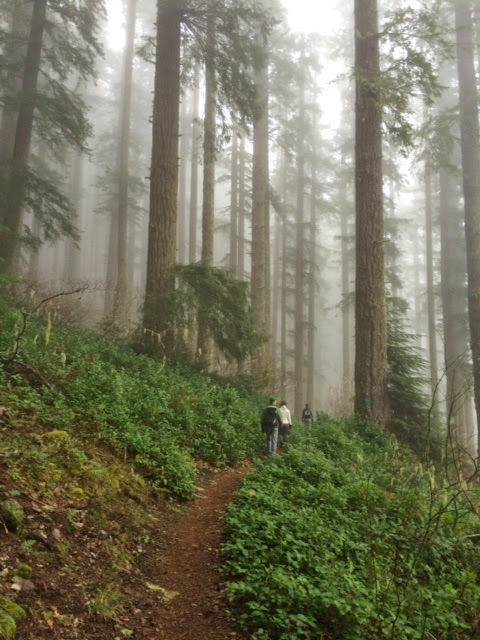Every National Forest has a guiding management plan, as required under the National Forest Management Act. In Oregon, the plans for most of our National Forests were completed in the late 1980s to early 1990s. These plans outline management guidelines and direction for each Forest - kind of like a zoning plan for a city. They address recreation, resource extraction, Wilderness and special areas, wildlife needs, and other important public values.

In 1994, the completion of the Northwest Forest Plan (NWFP) amended the plans for the National Forests within the range of the northern spotted owl, essentially another overlying zoning plan on the individual Forest Plans.
The NWFP attempted to strike a balance between logging and providing habitat for wildlife dependent on old-growth forests. The Plan defined areas for protecting and restoring old-growth habitat, set aside streamside areas to protect water quality and salmon habitat, and set strong standards for restoring forests and watersheds that were drastically damaged in the clearcutting epidemic that ravaged public forests in the 1970s and 80s.
The 20 years since the Northwest Forest Plan has been in place has led to great progress in restoring some of the damage done by unsustainable logging of previous decades. Water quality and salmon habitat has improved, old-growth logging has come to a halt, and the agencies are largely meeting their timber production targets by thinning in previously clearcut plantations with little controversy.
The US Forest Service is now considering if and how to revise management plans for National Forests within the NWFP area. To gather ideas on the revision process, share information, and outline its current thinking about a plan revision strategy, the Forest Service is holding a series of “public listening sessions” in the spring of 2015 to gather input on how to involve the public, what to consider in any plan revisions, and how to incorporate science into their plans. More information from the U.S. Forest Service is here.
Weighing in
Oregon Wild and our supporters have a long history of speaking up for our vision of forest management and protection. Throughout the process the Forest Service uses to revise the management plans for individual National Forests, or the Northwest Forest Plan as a whole, we will keep you, the public, informed and engaged.
Upcoming listening sessions and talking points for these first steps in the process in the spring of 2015 are listed below:
Listening Sessions
| Date | Location | Time | National Forest |
|---|---|---|---|
| April 27 |
Oregon State University |
6:00-8:00pm | Siuslaw |
| April 27 | Bowman Museum Annex 246 N. Main St., Prineville |
6:00-8:00pm | Ochoco |
| April 28 | Deschutes National Forest HQ 63095 Deschutes Market Rd., Bend |
5:30-8:30pm | Deschutes |
| April 28 | Douglas County Fairgrounds Community Hall Roseburg |
5:30-7:30pm | Umpqua |
| May 4 | Pleasant Hill High School 84455 N Enterprise Road, Pleasant Hill |
6:00-7:30pm | Willamette |
| May 4 | Lake County Fairgrounds Exhibit Bldg. #1 Lakeview |
6:00-8:30pm | Fremont-Winema |
| May 4 | Medford Interagency Office 3040 Biddle Rd., Medford |
5:30-7:30pm | Rogue River-Siskiyou |
| May 5 | Oregon Institute of Technology College Union 2nd Floor 3201 Campus Drive, Klamath Falls |
6:00-8:30pm | Fremont-Winema |
| May 6 | Stayton Community Center 400 W. Virginia St., Stayton |
6:00-7:30pm | Willamette |
| May 6 | Curry County Fairgrounds Docia Sweet Hall 29392 Ellensburg Ave., Gold Beach |
5:30-7:30pm | Rogue River-Siskiyou |
| May 11 | Columbia Gorge Hotel 4000 Westcliff Drive, Hood River |
6:00-8:00 | Mt. Hood & Gifford-Pinchot |
Talking Points
- There is no need for any radical revision of the plan – we’re only 20 years into a 100 year restoration plan. We knew that it would take decades to restore the damage done during the clearcutting binge that occurred prior to the Northwest Forest Plan. Let’s stay on course.
- There is a continued need for the NWFP as an integrated plan that sets standards for the protection and restoration of watersheds, salmon, wildlife habitat, and old-growth forests.
- Enhance and strengthen the NWFP reserve network by protecting all mature and old-growth forests and unroaded areas to provide for wildlife habitat needs in a changing climate and increasing pressure from habitat fragmentation and invasive species.
- The strong objectives and buffers for streams and riparian areas in the NWFP (the Aquatic Conservation Strategy) should be retained and built upon.
- Continue to build on the restoration begun under the Northwest Forest Plan – from adding diversity to young plantations, to reducing impacts from the extensive road system, to improving fish and wildlife habitat.
- The NWFP should be strengthened by using the best available science regarding climate change, wildlife habitat needs, and other relevant new information. The science synthesis conducted to inform plan revisions should ensure peer review and public participation.
- Any new plans should respond to climate change by focusing on (1) reducing environmental stressors like logging, road building, invasive species, and off-road vehicles; (2) establishing connecting corridors for wildlife migrations; and (3) providing high-quality habitat as refugia for climate-sensitive fish, wildlife, and plants. The plans should also recognize and safeguard the vast amount of forest carbon that makes the region’s National Forests critically important in fighting climate change.
- Any change to National Forest Plans should recognize the wide variety of social and economic benefits National Forests provide for local communities and the region as a whole, not just timber. Outdoor recreation on public lands is a growing industry, employing more than 140,000 people, whereas the timber industry has a declining fraction of Oregon’s economy.

